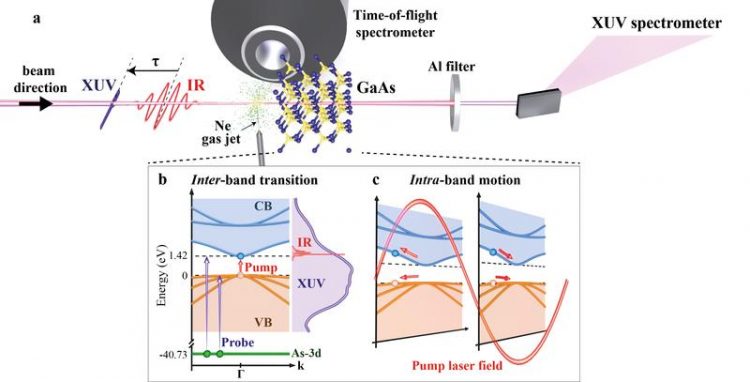Milestone study of excitation of electrons in GaAs at the attosecond level

(A) An intense few-cycle infrared (IR) laser pulse is combined with a single attosecond probe pulse with a spectrum in the extreme-ultraviolet (XUV) energy regime. Adapted from Schlaepfer et al., Nature Physics doi:10.1038/s41567-018-0069-0 (2018)
Fabian Schlaepfer and his colleagues in the experimental group of Ursula Keller at the ETH Institute for Quantum Electronics, together with Angel Rubio and Shunsuke Sato from the MPSD’s Theory department, combined transient absorption spectroscopy with sophisticated first-principles calculations to study and understand these processes. Their work has now appeared online in Nature Physics.
Gallium arsenide is a technologically important narrow-band-gap semiconductor, in which the excitation of electrons from the valence into the conduction band produces charge carriers that can transport electrical current through electronics components.
In addition to this so-called inter-band transition, carriers can also be accelerated within the individual bands as the electrons interact with the laser light. This intra-band motion is caused by the strong electric field associated with the laser light.
Which of the two mechanisms dominates the response to a short intense laser pulse, and how their interplay effects the carrier injection into the conduction band, is far from obvious.
The researchers found that intra-band motion does play an important role, as it significantly enhances the number of electrons that get excited into the conduction band. This finding was unexpected because intra-band motion alone is unable to produce charge carriers in the conduction band.
Their work has also now revealed that the nonlinear interplay between intra- and interband transitions opens a new excitation channel via virtually excited states at high pump intensities.
These results represent an important step forward in understanding the light-induced electron dynamics in a semiconductor on the attosecond timescale. The processes will be of practical relevance for future electronics and optoelectronics devices, whose dimensions become ever smaller and involve ever faster dynamics and ever stronger electric fields.
For further information please contact Jenny Witt, MPSD Press and PR
Tel.: +49 40 8998 6593
Email: jenny.witt@mpsd.mpg.de
Source publication: http://www.nature.com/articles/s41567-018-0069-0
Media Contact
More Information:
http://www.mpsd.mpg.deAll latest news from the category: Power and Electrical Engineering
This topic covers issues related to energy generation, conversion, transportation and consumption and how the industry is addressing the challenge of energy efficiency in general.
innovations-report provides in-depth and informative reports and articles on subjects ranging from wind energy, fuel cell technology, solar energy, geothermal energy, petroleum, gas, nuclear engineering, alternative energy and energy efficiency to fusion, hydrogen and superconductor technologies.
Newest articles

Sea slugs inspire highly stretchable biomedical sensor
USC Viterbi School of Engineering researcher Hangbo Zhao presents findings on highly stretchable and customizable microneedles for application in fields including neuroscience, tissue engineering, and wearable bioelectronics. The revolution in…

Twisting and binding matter waves with photons in a cavity
Precisely measuring the energy states of individual atoms has been a historical challenge for physicists due to atomic recoil. When an atom interacts with a photon, the atom “recoils” in…

Nanotubes, nanoparticles, and antibodies detect tiny amounts of fentanyl
New sensor is six orders of magnitude more sensitive than the next best thing. A research team at Pitt led by Alexander Star, a chemistry professor in the Kenneth P. Dietrich…





















